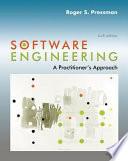
Software Engineering
For almost three decades, Roger Pressman's Software Engineering: A Practitioner's Approach has been the world's leading textbook in software engineering. The new seventh edition represents a major restructuring and update of previous editions, solidifying the book's position as the most comprehensive guide to this important subject. The seventh edition of Software Engineering: A Practitioner's Approach has been designed to consolidate and restructure the content introduced over the past two editions of the book. The chapter structure will return to a more linear presentation of software engi.
- ISBN 13 : 9780077415402
- ISBN 10 : 007741540X
- Judul : Software Engineering
- Pengarang : Roger Pressman,
- Bahasa : en
- Tahun : 2009
- Halaman : 924
- Google Book : http://books.google.co.id/books?id=JNDGtwEACAAJ&dq=inauthor:pressman,+intitle:software+engineering&hl=&source=gbs_api
-
Ketersediaan :
The seventh edition of Software Engineering: A Practitioner's Approach has been designed to consolidate and restructure the content introduced over the past two editions of the book.


